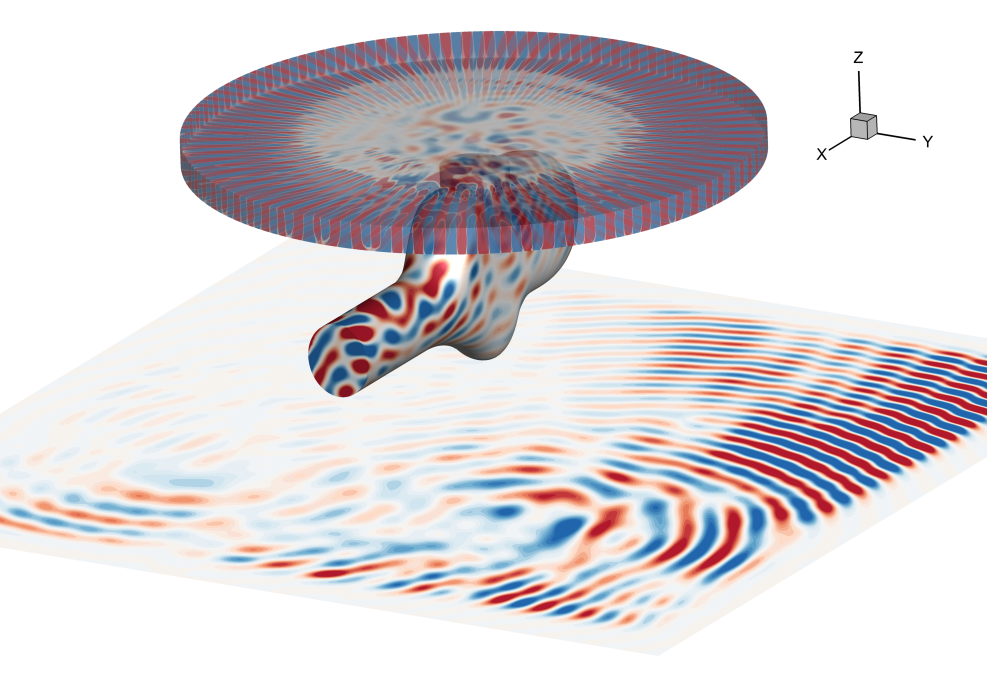Research on the rotorcraft aerodynamics and noise prediction technologies
JAXA Supercomputer System Annual Report February 2024-January 2025
Report Number: R24EDA201G28
Subject Category: Aeronautical Technology
- Responsible Representative: YASUE Kanako, Aviation Technology Directorate, Aviation Integration Innovation Hub
- Contact Information: IKEDA Tomoaki(ikedat@chofu.jaxa.jp)
- Members: Hirokazu Higashida, Kenji Hayashi, Tomoaki Ikeda, Masatoshi Kanayama, Yuki Kishi, Hideji Saiki, Kanako Yasue
Abstract
We aim at the development of aerodynamics and noise computation techniques for rotorcrafts by the unstructured-grid CFD code FaSTAR-Move that utilizes an overset moving grid approach. Extracting the unsteady CFD data obtained by FaSTAR-Move onto the noise source control surface defined around rotor blades, noise propagation is analyzed by iAWESOME a fast acoustic-equation solver that can consider noise-shielding effect as a coupled approach.
Reference URL
N/A
Reasons and benefits of using JAXA Supercomputer System
In this research topic, real-scale complicated models must be computed with real flow conditions, which requires large computer resources and is suited to the use of the JAXA supercomputer system.
Achievements of the Year
In this fiscal year, the interface for coupled analysis was developed extensively between FaSTAR-Move that provides near-field noise sources and iAWESOME that solves noise propagation in the frequency domain. Now, time history data obtained by FaSTAR-Move are projected onto the noise-source surfaces imported by iAWESOME after FFT is applied. In addition, a fast volumetric mapping function for flow-field is newly introduced from CFD to acoustic field. The coupled analysis function developed this year was applied to the HART-II benchmark problem. It was confirmed that the three-dimensional acoustic field is converged very fast at each discrete frequency to compute the BVISPL noise carpet.

Fig.1: Obtained results of HART-II model by FaSTAR-Move/iAWESOME coupling approach (instantaneous field, frequency: 21BPF)
Publications
- Oral Presentations
1) IKEDA Tomoaki, "On the effects of vortical motions on noise source surface for the acoustic wave equation in inhomogeneous medium," the 56th Fluid Dynamics Conference/the 42nd Aerospace Numerical Simulation Symposium, 2024.
2) YASUE Kanako, "On the advanced research of the airframe characteristics prediction toward the enhanced social acceptance of next generation air-mobility," the 20th Molecular Imaging Forum in Interdisciplinary Fields, 2024.
Usage of JSS
Computational Information
- Process Parallelization Methods: MPI
- Thread Parallelization Methods: N/A
- Number of Processes: 96 - 960
- Elapsed Time per Case: 200 Hour(s)
JSS3 Resources Used
Fraction of Usage in Total Resources*1(%): 0.62
Details
Please refer to System Configuration of JSS3 for the system configuration and major specifications of JSS3.
| System Name | CPU Resources Used(Core x Hours) | Fraction of Usage*2(%) |
|---|---|---|
| TOKI-SORA | 16343894.92 | 0.75 |
| TOKI-ST | 23055.22 | 0.02 |
| TOKI-GP | 0.00 | 0.00 |
| TOKI-XM | 0.00 | 0.00 |
| TOKI-LM | 409.49 | 0.03 |
| TOKI-TST | 0.15 | 0.00 |
| TOKI-TGP | 0.00 | 0.00 |
| TOKI-TLM | 0.00 | 0.00 |
| File System Name | Storage Assigned(GiB) | Fraction of Usage*2(%) |
|---|---|---|
| /home | 1213.59 | 0.82 |
| /data and /data2 | 127554.55 | 0.61 |
| /ssd | 30720.00 | 1.65 |
| Archiver Name | Storage Used(TiB) | Fraction of Usage*2(%) |
|---|---|---|
| J-SPACE | 7.01 | 0.02 |
*1: Fraction of Usage in Total Resources: Weighted average of three resource types (Computing, File System, and Archiver).
*2: Fraction of Usage:Percentage of usage relative to each resource used in one year.
ISV Software Licenses Used
| ISV Software Licenses Used(Hours) | Fraction of Usage*2(%) | |
|---|---|---|
| ISV Software Licenses(Total) | 105.45 | 0.07 |
*2: Fraction of Usage:Percentage of usage relative to each resource used in one year.
JAXA Supercomputer System Annual Report February 2024-January 2025


